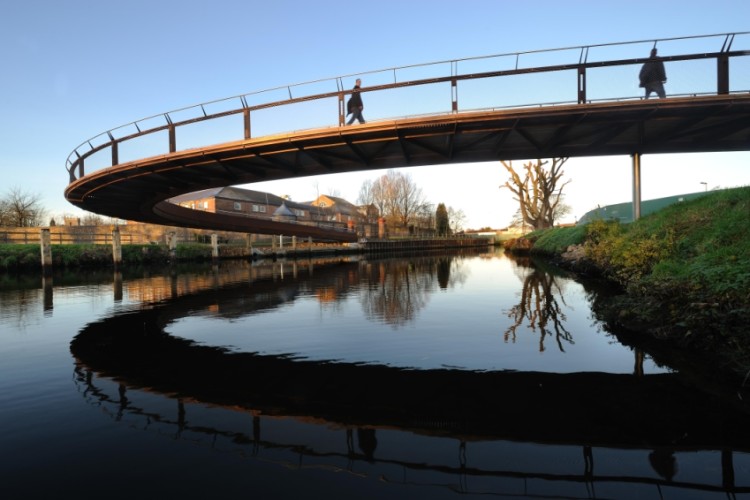The latest addition to Norwich city centre’s catalogue of bridges across the River Wensum is the Jarrold Bridge, a pedestrian and cycle crossing linking the historic city centre with a new riverside development.
Named after, and conceived by local businessman Peter Jarrold, the 80m-long bridge has a unique form that appears to float over the site with little visible means of support.
The project’s design brief required a structure that would make the most of the distant views of the cathedral and touch the ground lightly on both riverbanks.
Early in proceedings a number of schemes for the bridge were looked at, with a steel composite design, incorporating a hardwood deck, winning the day. The bridge is fixed by concrete abutments on each bank and propped by just two slender pin jointed stainless steel columns. The structure then acts as two mutually stabilising propped cantilevers.
Weathering steel
The main structure is fabricated from weathering steel which was chosen primarily for aesthetic reasons. The material develops a deep brown coating over time, which will be in keeping with the structure’s semi rural location.
Weathering steel also brings a number of maintenance and environmental benefits to the project, and should require no painting during its 120 year lifetime.
The deck surface is untreated renewable hardwood selected for its density, strength and durability. A clever and unique clamp system fixes the strips to bearers which are then bolted invisibly to the steel structure. Inset fibreglass strips ensure slip resistance in all weather.
Stainless steel top rails accentuate the curved form and a lightweight stainless steel mesh encloses the deck, allowing full visibility along and across the river. There are no applied finishes anywhere on these surfaces, further reducing maintenance requirements.
At each abutment there are two bearings: one fixed uplift bearing below the box girder and one sliding guided bearing under the balustrade. They both provide vertical, lateral and torsional restraint at the abutments.

Structurally the 80m span bridge consists of a curved primary box beam which carries cantilever supports for the decking. A closed steel box beam represented the optimum form to resist the bending and torsion experienced by the deck and allowed the designers to manipulate the cross sectional shape to achieve the required aesthetic and structural form.
Spine of the bridge
The box beam is also the spine of the bridge and all load from the deck and balustrade is transferred to the cantilevering cross beams. This then applies torsion and bending to the girders, the torsion in one arm of the bridge being resisted by the bending capacity of the other.
Horizontal loading is resisted as the bridge acts as an arch, supported by bracing which ties the box girder, the edge beam and the cross beams together. A tuned mass damper located inside the spine box girder at mid-span dampens vertical accelerations induced by resonant pedestrian loading.
Steelwork contractor SH Structures fabricated the bridge steelwork in five sections for ease of transportation to site. Once delivered, they were set up on temporary trestles, with the two midspan sections then welded together which resulted in three bridge segments.
During fabrication a lot of emphasis was placed on off site manufacture and site welds were minimised. SH Structures advised Ramboll throughout the design procedure about buildability of the bridge and also designed a bolted splice connection at midspan to remove any need for temporary works to be placed in the river during the erection process.
“Using a 1,000t capacity crane the bridge was quickly erected,” says SH Structures contracts manager Dave Perry. “We initially installed the two abutment sections and supported them on temporary works, then during the following day we installed the large central span.
“A large proportion of the timber decking was installed prior to the lifts and although this made the craneage programme heavier, it minimised the amount of work needed to be done over the water.”
Project fact file
- Jarrold Bridge, Norwich
- Client: Jarrold St. James
- Architect: Ramboll
- Main contractor: R.G Carter
- Structural engineer: Ramboll
- Steelwork contractor: SH Structures
- Steel tonnage: 70t
Got a story? Email news@theconstructionindex.co.uk



